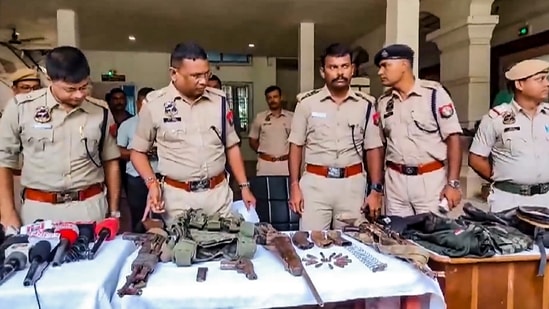Northeastern View | Manipur crisis spillover into Assam needs a humanitarian, not securitised, response from the govt
The latest killing of the Hmar individuals by Assam Police aggravates the cross-border spillover by adding a kinetic security component.
In the late hours of July 16, police in Assam’s Cachar district killed three Hmar individuals close to the hilly jungles bordering Manipur’s Jiribam district. Assam chief minister, Himanta Biswa Sarma, later tweeted that those killed with Hmar were “militants from Assam and neighbouring Manipur”. According to local police authorities in Cachar, the “militants” were part of a drug trafficking group and were killed in a gunfire exchange after being cornered.

A day later, the Hmar Students’ Association, in a statement, claimed that the three deceased were “village volunteers” who were defending “Kuki-Zomi-Hmar villages” from “Meitei militants” and were murdered extrajudicially by Assam Police after being detained. Another tribal organisation based in Manipur’s Jiribam and Pherzawl districts claimed that it was a “fake encounter”.
The shadowy incident comes on the heels of a sudden spike in violence between the Meitei and Kuki-Zo sides in western Manipur’s Jiribam district last month. It also reveals new complications along the Assam-Manipur border due to a direct spillover of the ongoing crisis in Manipur across state borders.
Manipur crisis spills over
Manipur’s Jiribam district, bordering Assam to the West, had been relatively calm since the conflict began in May last year. That changed on June 6 when the discovery of a maimed dead body of a Meitei farmer triggered violent clashes. Houses belonging to both Hmar and Meitei people were torched in the district, which is dominated by the Meitei but has several other minorities with significant numbers.
Following the clashes, hundreds fled across the border into Assam’s Cachar district. So far, some 1,700 Jiribam residents are reportedly living in Cachar in several relief camps. The Jiribam clashes and the ensuing displacement marked the first major spillover of the Manipur conflict into a neighbouring state other than Mizoram, which has received some 12,000 displaced people since the clashes began in May 2023.
The latest killing of the Hmar individuals by Assam Police aggravates the cross-border spillover by adding a kinetic security component. The displacement into Cachar had already put the local police on its toes. Last month, it even conducted a door-to-door survey in the district to identify the displaced from Manipur with the ostensible intent of preventing not just communal clashes, but also what the Assam Inspector General (Law and Order) referred to as “illegal activities.”
Top police officers from the Cachar and Jiribam districts met last month to discuss the forced displacement. There was likely a sense in Assam’s political-security establishment that the Jiribam situation would allow armed groups and other similar outfits to shuttle back and forth across the inter-state border and use Assam as a base.
Securitised approach
The cross-border movement of Internally Displaced Persons (IPDs) from Manipur to Assam has created a textbook humanitarian crisis. Media reports have revealed that the relief camps lack basic amenities, including clean water, medical aid, and access to income sources. There is also a general sense of insecurity.
However, the Assam government has yet to launch a comprehensive programme of humanitarian assistance to the displaced. Instead, it has taken an aggressive securitised approach to the IDP crisis, centring its interventions on preventing criminal activities. To this end, it has deployed fresh forces along NH-37, which connects Assam to the Imphal Valley.
In fact, coordination between state authorities in Assam and Manipur has been on the security, not humanitarian, front. Neither Dispur nor Imphal has yet deployed specialised administrative officers with a mandate to extend humanitarian assistance for those who had to flee across state lines. So far, only community-based organisations, such as local churches, have mobilised whatever limited aid has reached the affected people.
The recent killing of three Hmar “village volunteers”, one of whom was reportedly a local farmer, by the Assam Police reflects the adverse effects of securitising what is at its core a humanitarian crisis. Instead of operating with de facto suspicion and belligerence, especially against tribal communities living along the state border, the Assam government needs to work with community organisations and the displaced people to secure and stabilise the border with Manipur.
Fair probe needed
Dispur needs to take the disturbing allegations of extrajudicial murder that the Hmar organisations have levelled against the Assam Police seriously and probe them thoroughly. Failure to do so might generate a new wave of discontent among the border communities, which could then snowball into Manipur-like violence.
Therefore, in trying to prevent a repeat of the seemingly intractable crisis next door, the Assam government could end up repeating the grave mistakes of the Manipur government and projecting itself as an apathetic or biased entity.
More importantly, it is incumbent upon the NDA government in New Delhi to step in and stabilise the Assam-Manipur border by not just playing its role as a neutral political-security arbiter, but also helping both Dispur and Imphal in providing humanitarian assistance to the displaced people. Therefore, beyond deploying paramilitary personnel to secure the forested hills separating the two Northeastern states, the centre also needs to send civil officers to aid the displaced.
Angshuman Choudhury is a New Delhi-based researcher and writer, formerly an Associate Fellow at the Centre for Policy Research and focuses on Northeast India and Myanmar. The views expressed are personal.
All Access.
One Subscription.
Get 360° coverage—from daily headlines
to 100 year archives.



HT App & Website







